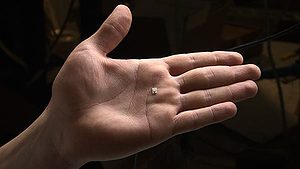Implantable medical devices, capable of delivering drugs or performing micro-surgery from inside the body, have been the subject of scientific research for decades now. A number of exciting prototypes have been developed in the past few years, as miniaturization allowed it, however reliability flaws rendered them unpractical. A new tiny device developed by Stanford electrical engineers, was presented this week at the International Solid-State Circuits Conference by lead researcher Ada Poon, which is powered without wires or batteries and is small enough to travel through human blood streams.
“Such devices could revolutionize medical technology,” said Poon, an Electrical Engineering Assistant Professor. “Applications include everything from diagnostics to minimally invasive surgeries.”

In front of the conference audience, Poon demonstrated the working device, just a few millimeters in size and wirelessly powered, capable of controlled motion through a fluid, including blood. This could be the first of a new class of working medical implants, which could deliver drugs, perform analyses, and perhaps even zap blood clots or remove plaque from sclerotic arteries all from inside the human body. Since its power is derived wirelessly using electromagnetic radio waves, the device escapes all the reliability issues other implants meant for similar applications encountered. No batteries or wires means that the device can travel through the blood stream without risk of power failure and a dramatic scale down in size (batteries amount to most of the volume of such devices).
“While we have gotten very good at shrinking electronic and mechanical components of implants, energy storage has lagged in the move to miniaturize,” said co-author Teresa Meng, a professor of electrical engineering and computer science. “This hinders us in where we can place implants within the body and also creates the risk of corrosion or broken wires, not to mention replacing aging batteries.”
A tiny surgeon inside your blood vessels
Scientists have been trying to devise such medical wirelessly powered implants for 50 years now, but it seems the approach taken in the past was wrong, all because of one flawed assumption – that the human tissue is a good electrical conductor. Couldn’t been farther from the truth. With this inaccurate model in mind, high-frequency waves dissipate in the human tissue, dissipating as the device travels further.
Poon took a different approach, and considered the human tissue as a dielectric, a type of insulator – quite the opposite of previous assumptions! In a dielectric, the signal is conveyed as waves of shifting polarization of atoms within cells, which renders radio waves propagation possible. Moreover, the human tissue has been found to be “low-loss” dielectric, which means signal loss is minimal. Again, the opposite of past assumptions. These have all been demonstrate experimentally and mathematically.
“When we extended things to higher frequencies using a simple model of tissue, we realized that the optimal frequency for wireless powering is actually around one gigahertz,” said Poon, “about 100 times higher than previously thought.”
This revelation was instrumental to the researchers’ development, since it allowed them to build the device 100 times smaller and yet deliver the power needed by the medical device. This is why the antenna is just 2mm in size – small enough to travel through blood streams.
[RELATED] Nanotech powered by your breath
Two types of self-propelled devices were developed and demoed. One generates direction force to push itself forward by driving electrical current directly through the blood stream, allowing for velocity of around half a centimeter per second. The other, moves similar to the way a kayaker paddles upstream, switching current back and forth through a wire loop.
“There is considerable room for improvement and much work remains before such devices are ready for medical applications,” said Poon. “But for the first time in decades the possibility seems closer than ever.”






